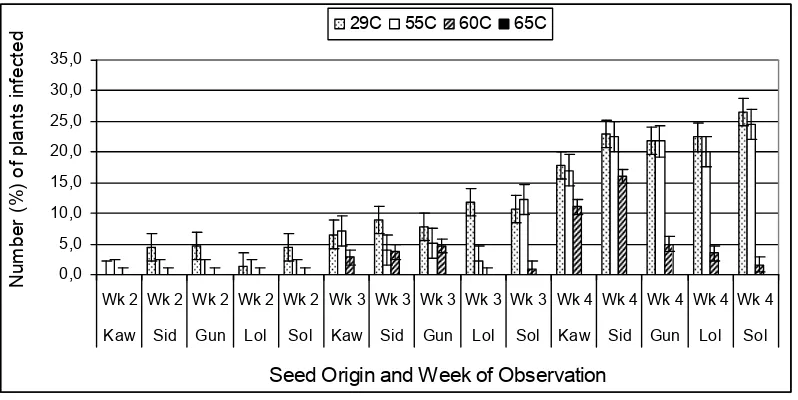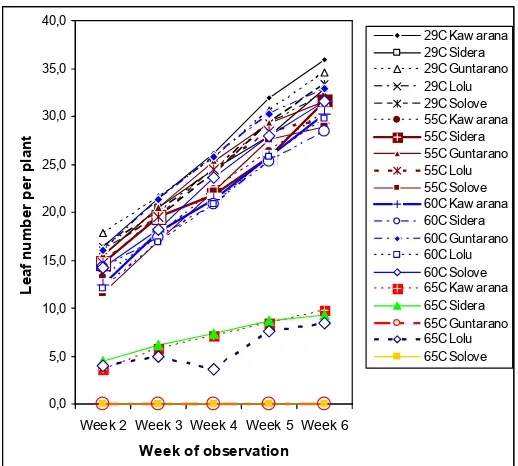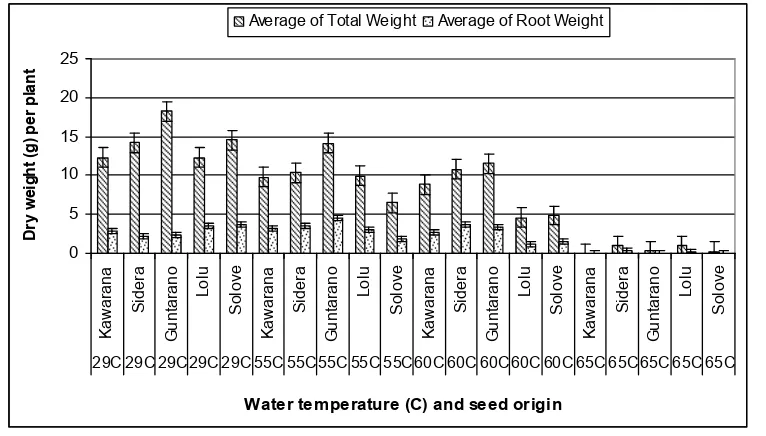Pudji Sulaksono
Laboratory of Plant Pests And Diseases Department, Agricultural Faculty, Tadulako University, Palu 2006
pudsul@yahoo.co.uk
Abstract
The following observations on the seemingly prevalent occurrence of peanut (Arachis hypogaea) seed contaminations by PtMtV virus in the surrounding area of Palu, Central Sulawesi were conducted to determine the level of seed contamination and whether hot water treatment can be used to eliminate PtMtV virus from the seeds. Peanut seeds were collected from a number of locations and after soaking them in unheated water (29C) and heated water (55, 60 and 65C) for 10 minutes they were allowed to germinate, then transplanted and grown in pots in screen house. The effects of hot treatments on seed germinability, leaf formation, frequency of infection on surviving plants, and plant biomass production were determined. Seeds soaked in heated water showed different germinability, grew to become plants with different leaf formation and plant biomass production. Heat treatments gave different frequencies of infection on the plants. However, not a single heat treatment gave satisfactorily results in terms of giving zero or low infection and at the same time giving desirable seed germinability, leaf number, and plant biomass. The prospect of using hot water treatment at 55C or lower with longer soaking duration as a method for PtMtV virus elimination from peanut seeds is discussed.
Key words: virus, PtMtV, peanut, Arachis hypogaea, soaking, heat treatment, mottle
Introduction
Peanut (Arachis hypogaea) growing regions in Central Sulawesi Province include Tavaeli, Sirenja, Banggai Islands, and Parigi. Peanut was also grown in vast numbers in the region of Morowali, in east-southern part of the province. Peanut Mottle Potyvirus (PtMtV) disease has been recovered from peanut seeds collected from a number of peanut growing areas around Palu, Central Sulawesi (Nurrahmah, 2004). In 2003, the present author personally observed an almost 100% peanut mottle virus incidence in plants grown from several seed lots of peanuts bought from farmers who normally used the same seeds for planting their crops.
one occasion may mean big losses in other occasion, depending on a number of uncontrollable factors. It is then fair to suspect that PtMtV may cause peanut yield losses higher than the figures already reported when favorable conditions for disease are prevailing.
Economic losses due to viral disease can also be in the form of reduced or spoiled seed quality. BPMV disease causes poor soybean seed quality and reduce marketable price (Ziems et al., 2001). There is also other kind of loss. PtMtV-infected seeds of peanut do not change in appearance. But since the virus is carried through the seeds therefore germplasm exchange by means of seeds risks virus disease transmission to formerly virus-free area. Contamination of previously virus-free area with virus can bring damaging consequences to the plant protection conditions in the area concerned. The disease is also known to be spread by several species of vector insects, generally those of Aphididae family members.
The situation with peanut and PtMtV disease in Palu can be regarded as frustrating. Peanut seed contamination most likely occurs in high incidence while control of the PtMtV disease is dependent more on virus-free certified seeds, resistant varieties and control of virus vectors. Certified seeds and resistant cultivars are not yet available or will not likely be available within several years in regions around Palu. Chemical control of Aphid insect vectors can be done but its effectiveness for curbing virus spread is questionable if seed contamination is already high. It is indispensably urgent to verify the degree of contamination in local peanut seeds to work out the possibility of using the seeds for planting material. It is also essential to evaluate any practical and relatively cheap control methods. Heat treatment for plant propagation material has not been being in much discussion in the recent years. Quite a number of years ago it had been generally referred by workers as a way for virus inactivation or elimination from planting material (Johnstone and Wade, 1974; Nair, 1973; Sward and Hallam, 1976; Kriedemann et al., 1976; Hernadi, 1996; Smee and Ikin, 1975). Heat treatment method that is used to eliminate the virus in seeds should be one that does not detrimentally affect growth and yield of the crops grown from the seeds. Heat treatment has been used by Hernadi (1996) successfully to reduce seed infection of groundnut mosaic virus from 35 to 5% without seemingly being deleterious to the plant growth and development. Since seed heat treatment is cheap and practicable even at rural setting this method may offer solution for the problem of PtMtV disease in peanut.
This paper reports the investigation for determining the incidence of PtMtV contamination of peanut seeds and heat treatment temperature that eliminates viral infection from seeds while keeping growth and development quality of the seeds.
Material and Method
for ten minutes. The room temperature of this water was found to be 29ºC. Three replicates were made for every treatment.
The treated seeds were planted in a tray already filled soil and allowed to grow in the laboratory (a tray was planted with 25 seeds from the same location of origin and of the same heat treatment). Observation was made for the number of seeds that developed to normal and abnormal seedlings and that showed symptom of PtMtV infection. After two weeks, the surviving plants were transferred to polybag and moved to screenhouse.
Fertilizers at the dosages equivalent to the recommended ones (0.075g urea, 0.15g SP36, and 0.075g KCl per polybag) were given to the plant when the plants were 15 days old (a day after transplantation). The fertilizers were placed at and mixed with the soil at about 5 cm away from the stem base. Watering was given twice every day, in the morning and at the dusk time. The following variables were measured:
a. Germinability (in percent) and vigor of the seeds in the trays. Germinability was determined by dividing the number of normally germinating seeds by the total number of seeds observed. Vigor status was established by the physical appearance of the seed growth.
b. Incubation period of PtMtV infection symptom on the leaves was determined with plants still on the tray.
c. After the plants were moved to the screenhouse disease incidence was determined at 2, 3, 4, 5 dan 6 weeks after seeding. Percent value was calculated by dividing the number of plants with disease symptom with the total number of surviving plants observed.
d. Number of leaves per plant was determined from three plants taken randomly from the existing surviving population at 2, 3, 4, 5 and 6 weeks after seeding.
e. Dry weight of whole individual plant. This was done by removing the plant with its roots, removing the soil from the root by washing, and placing the plant material in the oven until constant weight. The dried plant was then placed on a balance to weigh.
Result and Discussion
0,0 5,0 10,0 15,0 20,0 25,0 30,0 35,0
Wk 2 Wk 2 Wk 2 Wk 2 Wk 2 Wk 3 Wk 3 Wk 3 Wk 3 Wk 3 Wk 4 Wk 4 Wk 4 Wk 4 Wk 4 Kaw Sid Gun Lol Sol Kaw Sid Gun Lol Sol Kaw Sid Gun Lol Sol
Seed Origin and Week of Observation
Num
ber
(%
) o
f pl
ant
s i
nf
ect
ed 29C 55C 60C 65C
Figure 1. PtMtV infection frequency on peanut plants grown from seeds previously treated with hot water (vertical bars represent the standard errors). Note: No symptoms could be detected visually on the plants on weeks five and six and observation for symptoms was then terminated.
Hot water treatments affect seed infection levels, seed germinability, leaf formation and plant biomass production irrespective of the origins of the seeds used (Figures 1 to 4). Germinability was significantly reduced after the seeds were soaked in water at 60 and 65C but was relatively not changed after being soaked in water at 55C as compared to germinability given by soaking at 29C (control). Although soaking at 60C results in significantly low level of infection and gives leaf formation comparable to those given by soaking at 29C (control) and at 55C but this achievement is gained at the expense of great loss of seed germinability and total plant biomass. Soaking at 65C was found even to result in very poor seed germinability and very poor leaf formation and production of plant biomass. From overall results (Figures 1 to 4), none of the hot water treatments studied seems to be a satisfactory method for freeing seed from PtMtV infestation.
The PtMTV virus’s thermal inactivation point (TIP) is approximately between 53 and 65°C (Murayama et al., 1998; Brunt et al., 1996). Therefore, soaking seeds in water at 55°C should be adequate for at least inactivating the virus, although this was not the case in the present experiment. Exposure of seeds for 10 minutes to the heat in this experiment might be too short to allow the temperature of 55°C to inactivate or kill the virus; instead a longer exposure period may be required. A sustained period of 3-6 month-exposure to temperature of 37-40°C for grapevine plant material is needed to eliminate virus from the material (Kriedemann et al., 1976). To aid the survival of the plant material in the rigorous conditions due to heating, the workers gave the material CO2 enrichment treatment after
0,0
Figure 2. Germinability of peanut seeds taken from different places of origin and treated with hot water at various temperatures (vertical bars represent the standard errors)
Sward and Hallam (1976) investigated structural changes in the meristem tips of potato following heat therapy and observed abberant changes in endoplasmic reticulum, ribosomes, mitochondria, chloroplasts and membrane systems. They stated that a combination of these changes retard viral spread and development in the heated meristem. Rashid et al. (2004) observed more than 70% of the non-primed mungbean plants (Vigna radiata) to have severe or lethal symptoms of mungbean yellow mosaic virus (MYMV) whereas only 14% of the primed plants were similarly affected. The investigators conducted the seed priming with water for 8 hours. The marked differences between priming treatments in the incidence of disease were also found to reflect in the components of yield. Primed crops produced 80% more above-ground biomass (3.3 versus 1.9 t ha 1), 264% more pod yield (1.0 versus 0.28 t ha1) and 415% more grain
(0.36 versus 0.07 t ha1) than did non-primed crops. Thus in the light of these findings and
the report of Kriedemann et al. (1976) mentioned earlier that grapevine plant may be freed from virus with heat therapy at 37-40°C it may be possible to obtain a temperature lower than 55°C administered for certain duration that can be used for PtMtV elimination from peanut seeds and at the same time gaining well growing and yielding crops.
0,0
0
29C 29C 29C29C 29C 55C 55C55C 55C 55C60C 60C 60C60C 60C 65C 65C65C 65C 65C
Water temperature (C) and seed origin
Average of Total Weight Average of Root Weight
Figure 4. Effect of soaking peanut seeds gained from different origins in heated water on the plant biomass (vertical bars represent the standard errors)
Conclusion
The level of PtMtV contamination of peanut seeds used for planting crops in regions around Palu, Central Sulawesi, is about 20% and this is considered epidemiologically alarming. Among the hot water treatments studied using temperatures of 29, 55, 60, and 65°C, none is satisfactory to be used for elimination method of PtMtV from peanut seeds. Duration of soaking for 10 minutes is thought to be too short for hot water therapy at 55°C to be effective. There is a need for further work to investigate whether water temperature of 55°C or lower combined with soaking durations longer than 10 minutes can be effective for both eliminating PtMtV from peanut seeds and retaining well growing and productive crops.
Acknowledgement
The present author is deeply indebted to Roosmiaty Mangantjo for helping in the carrying out and contributing to the funding of the experiments.
References
Brunt, A.A., K. Crabtree, M.J. Dallwitz, A.J. Gibbs, L. Watson, and E.J. Zurcher (eds.) (1996 onwards). `Plant Viruses Online: Descriptions and lists from the VIDE database. Version: 20th August 1996.' URL http://biology.anu.edu.au/Groups
/MES/vide/ (accessed 20th August 1996).
Cihlar-Strunk C. L. and M.A.C. Langham. 2004. Bean pod mottle virus effects on yield of ten soybean lines. APS Abstracts of Presentations. Phytopathology 94: S19.
Damicone, J.P. and J.L. Sherwood. 2003. Viral diseases of peanut (on line). Available online at http://www.pearl.agcomm.okstate.edu/plant diseases/f.7187.pdf (accessed 14th August 2003).
Hernadi, R., 1996. Pengaruh perlakuan ar panas terhadap biji kacang tanah pembawa groundnut mosaic virus. Buletin Budidaya Pertanian 2(1): 17-25.
Johnstone, G.R. and G.C. Wade. 1974. Therapy of virus-infected plants by heat treatment
Kriedemann, P.E., R.J. Sward, and W.J.S. Downton. 1976. Vine response to carbon dioxide enrichment during heat therapy. Australian Journal of Plant Physiology 3(5): 605-618 (Abstract).
Murayama, D., H.O. Agrawal, T. Inoue, J. Kimura, E. Shikata, K. Tomaru, T. Tsuchizaki, and Triharso (eds.). 1998. Plant Viruses in Asia. Gadjah Mada University Press, Yogyakarta.
Nair, N.G. 1973. Heat therapy of virus-infected cultures of the cultivated mushroom Agaricus bisporus. Australian Journal of Agricultural Research 24 (4): 553 – 541 (Abstract).
Nurrahmah, A., 2004. Keberadaan Penyakit Virus Terbawa Benih pada Kacang Tanah yang Dipasarkan di Daerah Biromaru. Skripsi, Fakultas Pertanian, Universitas Tadulako.
Rashid,A., D. Harris, P. Hollington, and S. Ali. 2004. On-farm seed priming reduces yield losses of mungbean (Vigna radiata) associated with mungbean yellow mosaic virus in the North West Frontier Province of Pakistan. Crop Protection23 (11): 1119-1124 (Abstract).
Semangun, H. 1993. Penyakit-penyakit Tanaman Pangan di Indonesia. Gadjah Mada University Press, Yogyakarta.
Smee, L and R. Ikin. 1975.Technical notes. A simple low-cost cabinet for heat therapy of virus infected plants. Australian Plant Pathology Society Newsletter 4 (2): 15 – 16. Sulaksono, P. 2005.Yields Losses Associated With Peanut Mottle Virus (PtMtV) Infection
on Peanut Plants Given Different Regimes of Urea And Potassium Chloride Fertilizers. Research Report, Agricultural Faculty, Tadulako University.
Šutič, D.D., R.E. Ford, and M.T. Tošič. 1999. Handbook of Plant Virus Diseases. CRC Press, Boca Raton.
Sward, R.J. and N.D. Hallam. 1976. Changes in fine structure of the potato meristem following heat treatment for virus eradication. Australian Journal of Botany 24(5): 597-605 (Abstract).
Ziems, A.D., L.J. Giesler, G.L. Graef, and L.C. Lane. 2001. Effect of bean pod mottle virus on soybean seed quality. APS Abstracts of Presentations, Phytopathology 91: S100. Yang, Y., K.S. Kim, and E.J. Anderson. 1997. Seed transmission of cucumber mosaic


